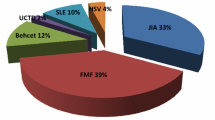Abstract
We correlated the distribution and levels of serum anti-cardiolipin (aCL) and anti-β 2-glycoprotein-1 antibodies (anti-β 2-GPI) of the IgG and IgM isotypes to the clinical spectrum of recent (<6 months) thromboembolic events in a cohort of 162 patients. Clinical information was obtained by questionnaires from the referring physicians. Cerebro-vascular infarction (CVI) had taken place in 82 patients, deep venous thrombosis (DVT) in 34, pulmonary embolism (PE) in 14, myocardial infarction (MI) in four, and other thromboses in 28 patients. SLE was the most commonly associated rheumatic disease and accounted for 20 (12%) patients. In 124 (77%) patients no underlying rheumatic disease was identified. Isolated IgG aCL was found in 31 of 48 patients with DVT/PE (65%), but in only 21 of 82 patients with CVI (26%); p < 0.0001. IgG anti-β 2-GPI were detected in 23 (48%) DVT/PE patients, but in only 13 (16%) CVI patients; p < 0.001. The IgG class anti-β 2-GPI positive patients had significantly higher levels of IgG aCL (mean 65 units) compared to IgG anti-β 2-GPI negative patients (mean 29 units); p < 0.0001. In contrast, isolated IgM aCL was found in nine (19%) patients with DVT/PE, but in 46 (56%) CVI patients; p < 0.0001. Only ten patients had IgM anti-β 2-GPI. The present study shows that the IgG and IgM aCL isotypes seem to define different clinical subsets of patients with thrombo-embolic events with IgG aCL being most prevalent in the group having DVT/PE, IgM aCL being found primarily among CVI patients.
Similar content being viewed by others
References
Cervera R, Piette JC, Font J, Khamashta MA, Shoenfeld Y, Camps MT et al (2002) Antiphospholipid syndrome: clinical and immunologic manifestations and patterns of disease expression in a cohort of 1,000 patients. Arthritis Rheum 46(4):1019–1027
Ruiz-Irastorza G, Khamashta MA, Hughes GRV (2002) Hughes syndrome crosses boundaries. Autoimmun Rev 1:43–48
Asherson RA, Khamashta MA, Ordi-Ros J, Derksen RH, Machin SJ, Barquinero J et al (1989) The “primary” antiphospholipid syndrome: major clinical and serological features. Medicine (Baltimore) 68(6):366–374
Levine JS, Branch DW, Rauch J (2002) The antiphospholipid syndrome. N Engl J Med 346(10):752–763
Tuhrim S, Rand JH, Wu XX, Weinberger J, Horowitz DR, Goldman ME et al (1999) Elevated anticardiolipin antibody titer is a stroke risk factor in a multiethnic population independent of isotype or degree of positivity. Stroke 30(8):1561–1565
Ahmed E, Stegmayr B, Trifunovic J, Weinehall L, Hallmans G, Lefvert AK (2000) Anticardiolipin antibodies are not an independent risk factor for stroke: an incident case-referent study nested within the MONICA and Vasterbotten cohort project. Stroke 31(6): 1289–1293
Toschi V, Motta A, Castelli C, Paracchini ML, Zerbi D, Gibelli A (1998) High prevalence of antiphosphatidylinositol antibodies in young patients with cerebral ischemia of undetermined cause. Stroke 29(9):1759–1764
Bushnell CD, Goldstein LB (2000) Diagnostic testing for coagulopathies in patients with ischemic stroke. Stroke 31(12):3067–3078
Harris EN (1990) Special report. The second international anti-cardiolipin standardization workshop/the kingston anti-phospholipid antibody study (KAPS) group. Am J Clin Pathol 94(4):476–84
Voss A, Jacobsen S, Heegaard NH (2001) Association of beta 2-glycoprotein I IgG and IgM antibodies with thrombosis and thrombocytopenia. Lupus 10(8):533–538
Erickson EN Jr, Najmey SS, Keil LB, El Kadi HS, DeBari VA (1996) Reference calibrators for IgG antibodies to beta 2-glycoprotein I: preparation, properties and availability to investigators. Clin Chem 42(7): 1116–1117
Wilson WA, Gharavi AE, Koike T, Lockshin MD, Branch DW, Piette JC et al (1999) International consensus statement on preliminary classification criteria for definite antiphosphol-ipid syndrome: report of an international workshop. Arthritis Rheum 42(7):1309–1311
Verro P, Levine SR, Tietjen GE (1998) Cerebrovascular ischemic events with high positive anticardiolipin antibodies. Stroke 29(11):2245–2253
Chakravarty KK, Byron MA, Webley M, Durkin CJ, Hillawi AH, Bodley R et al (1991) Antibodies to cardiolipin in stroke: association with mortality and functional recovery in patients without systemic lupus erythematosus. Q J Med 79(289):397–405
Ginsburg KS, Liang MH, Newcomer L, Goldhaber SZ, Schur PH, Hennekens CH et al (1992) Anticardiolipin antibodies and the risk for ischemic stroke and venous thrombosis. Ann Intern Med 117(12):997–1002
Szczepanski M, Cieslak E, Gardas A, Bauer A, Majkowski J (1998) Prevalence of high IgM anticardiolipins in patients with ischemic stroke. Eur J Neurol 5(3):287–290
Meroni PL, Riboldi P (2001) Pathogenic mechanisms mediating antiphospholipid syndrome. Curr Opin Rheumatol 13(5):377–382
Roubey RA (1994) Autoantibodies to phospholipid-binding plasma proteins: a new view of lupus anticoagulants and other “antiphospholipid” autoantibodies. Blood 84(9):2854–2867
Vazquez-Mellado J, Llorente L, Richaud-Patin Y, Alarcon-Segovia D (1994) Exposure of anionic phospholipids upon platelet activation permits binding of beta 2 glycoprotein I and through it that of IgG antiphospholipid antibodies. Studies in platelets from patients with antiphospholipid syndrome and normal subjects. J Autoimmun 7(3):335–348
Author information
Authors and Affiliations
Corresponding author
Additional information
Published online: 22 September 2005
Rights and permissions
About this article
Cite this article
Locht, H., Wiik, A. IgG and IgM isotypes of anti-cardiolipin and anti-β 2-glycoprotein i antibodies reflect different forms of recent thrombo-embolic events. Clin Rheumatol 25, 246–250 (2006). https://doi.org/10.1007/s10067-005-1166-x
Received:
Revised:
Accepted:
Issue Date:
DOI: https://doi.org/10.1007/s10067-005-1166-x




